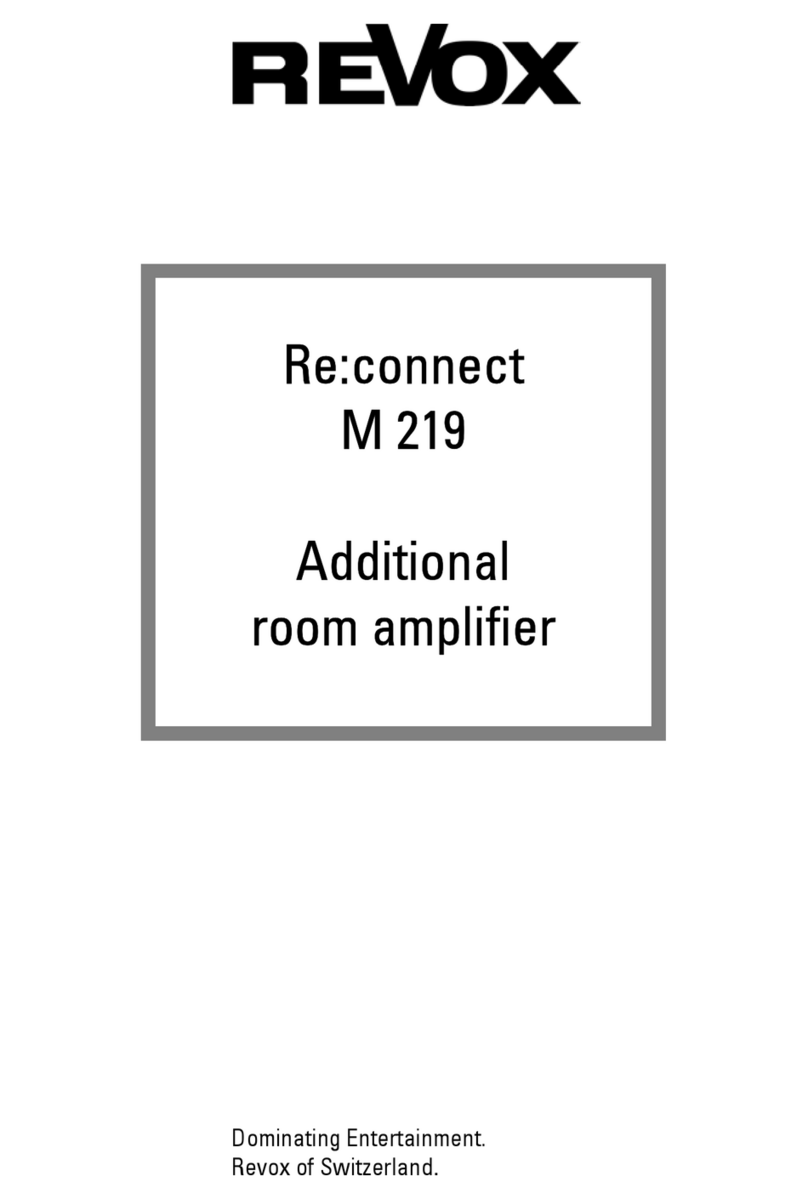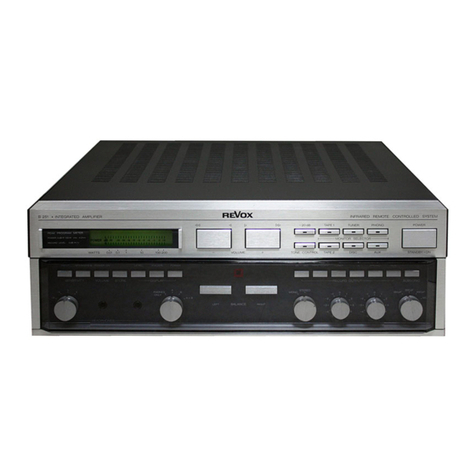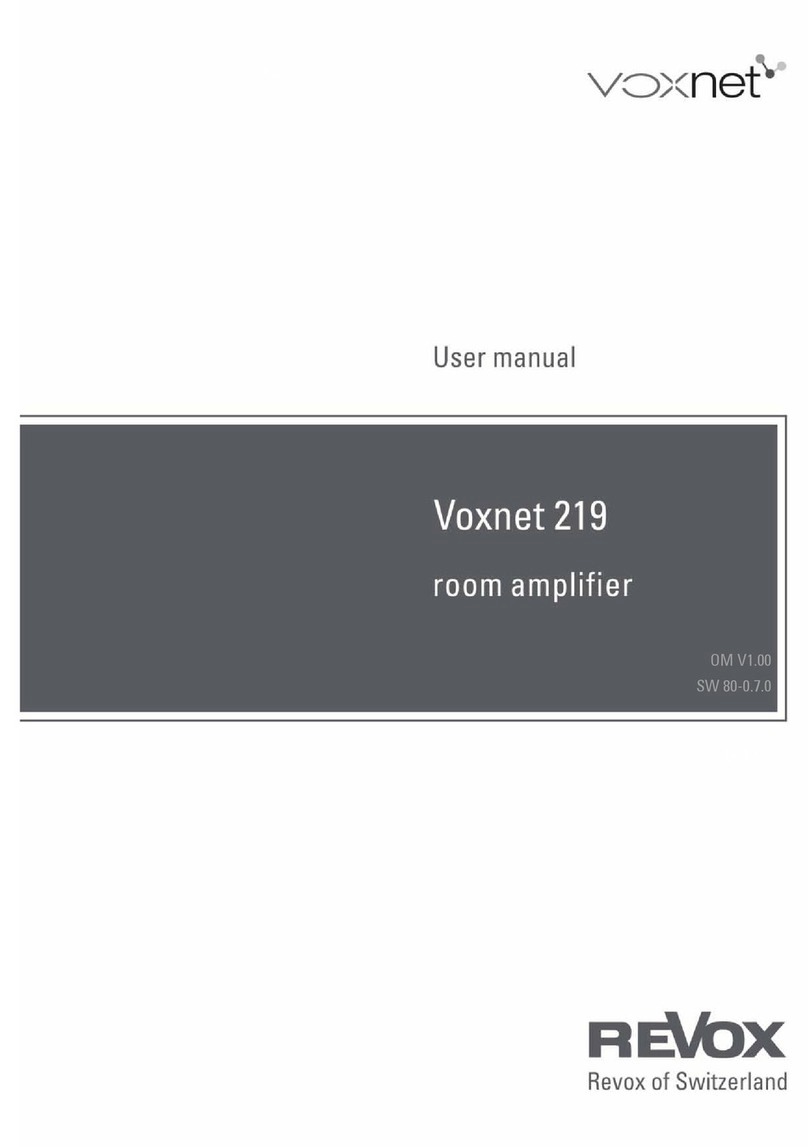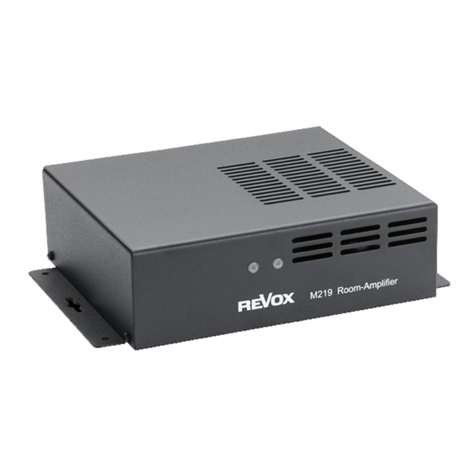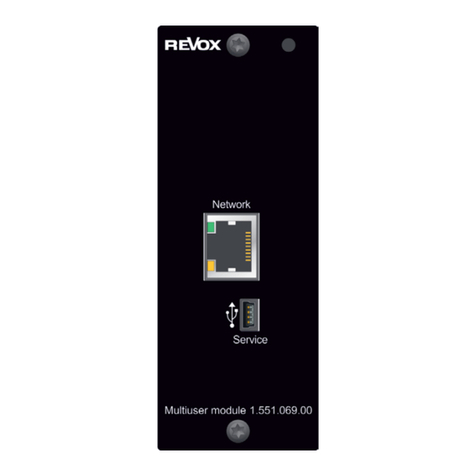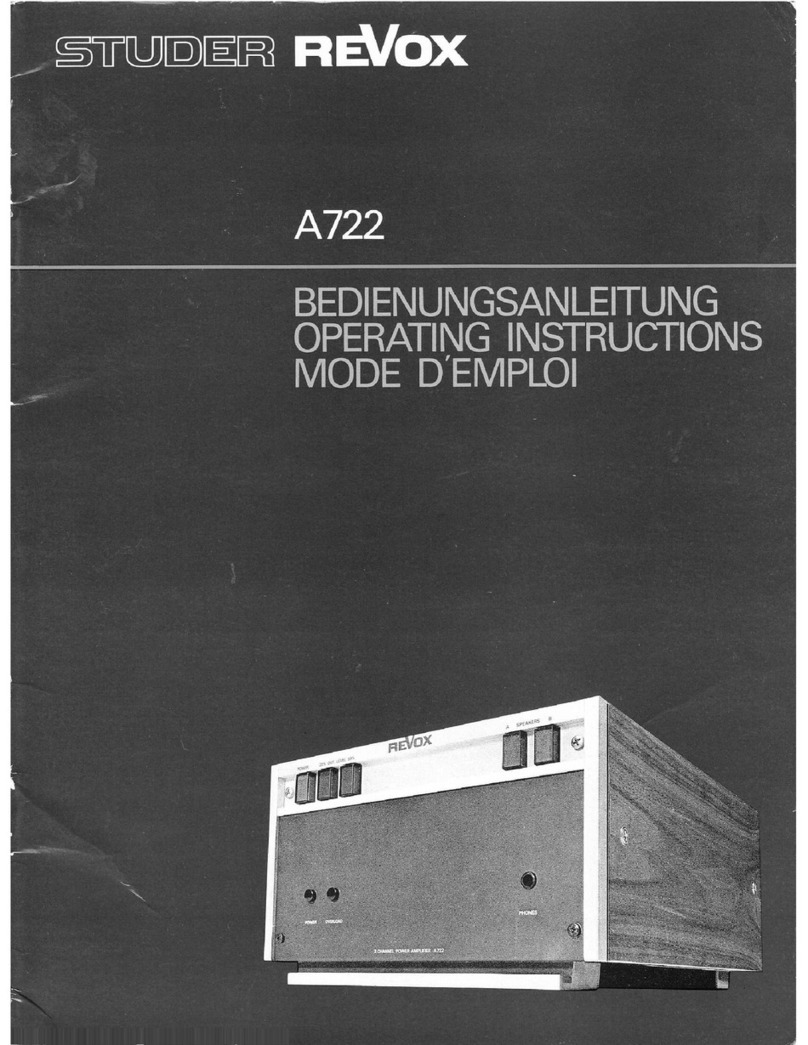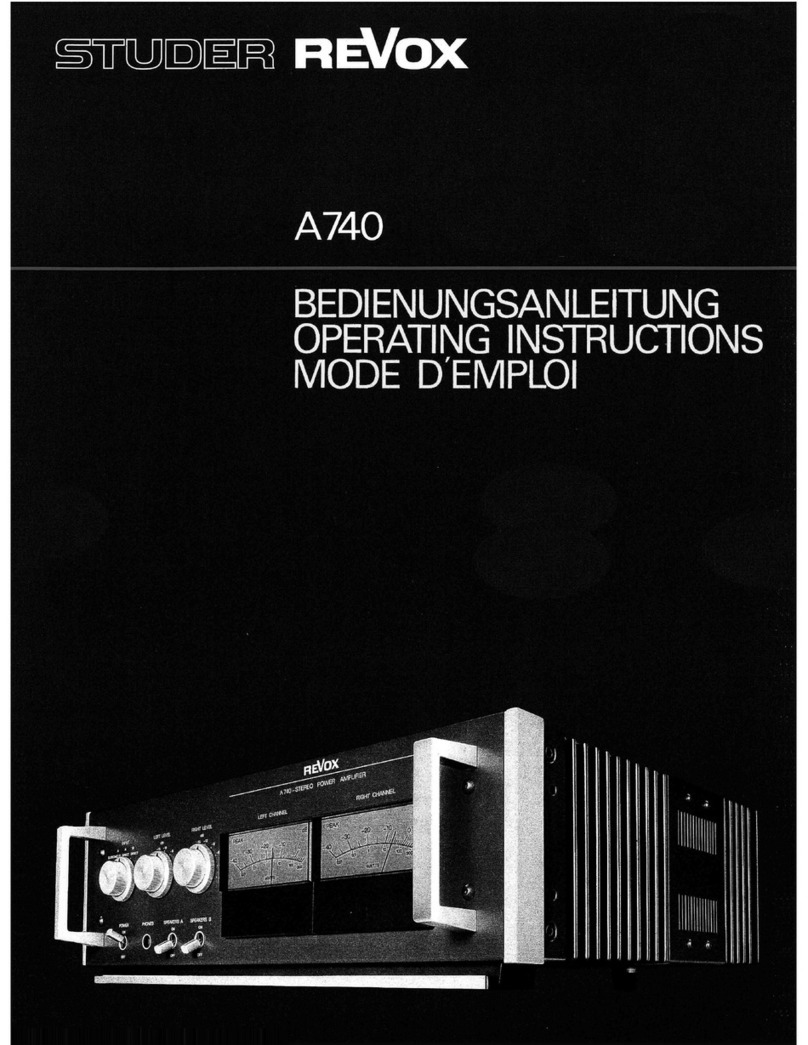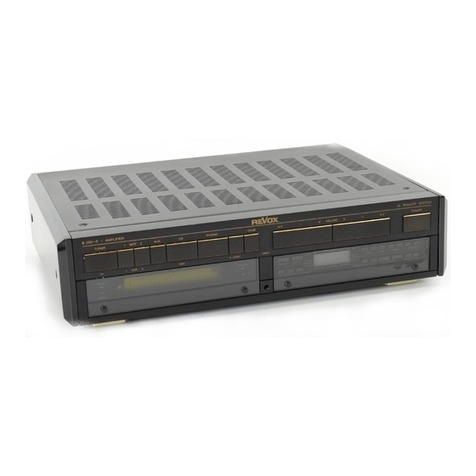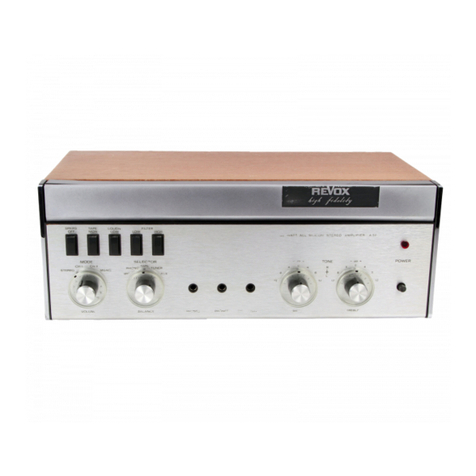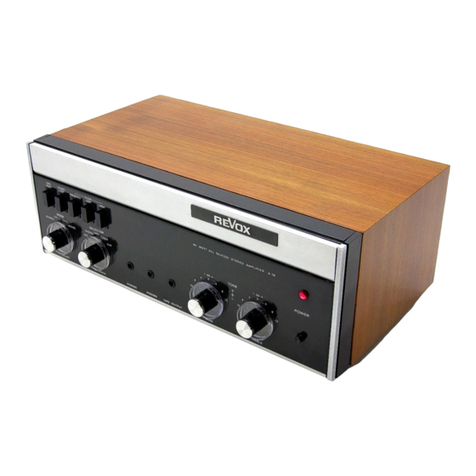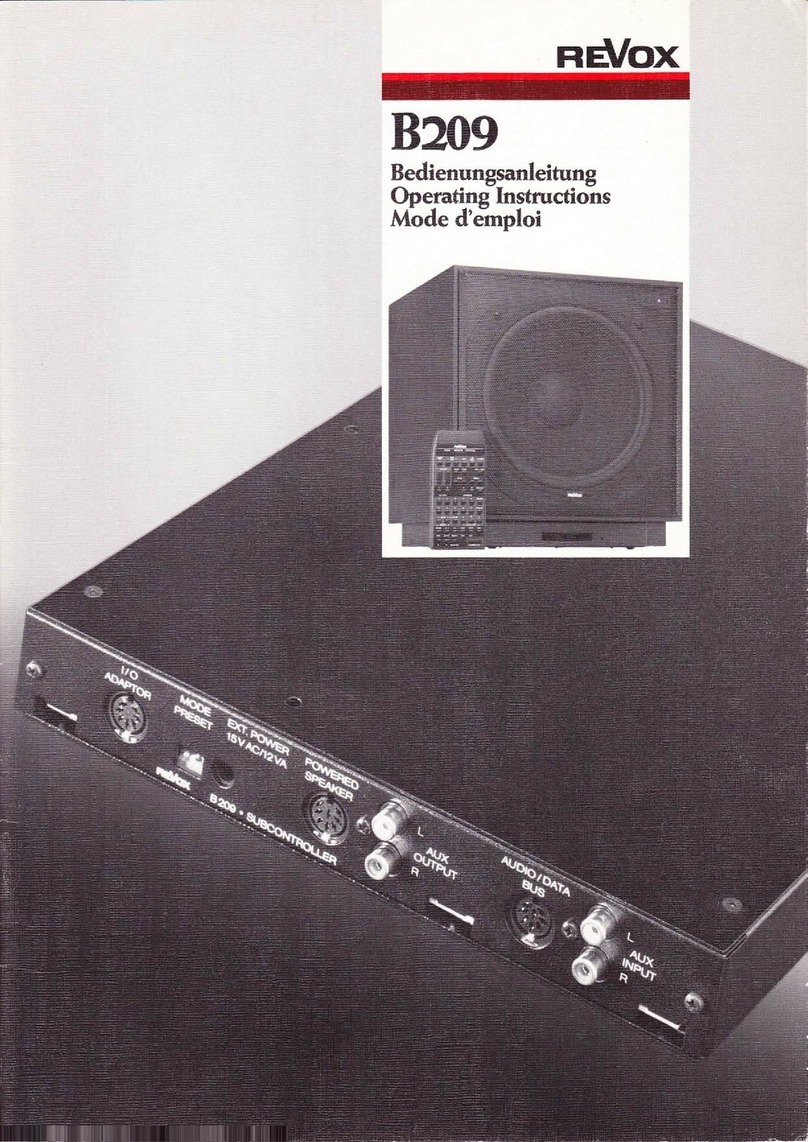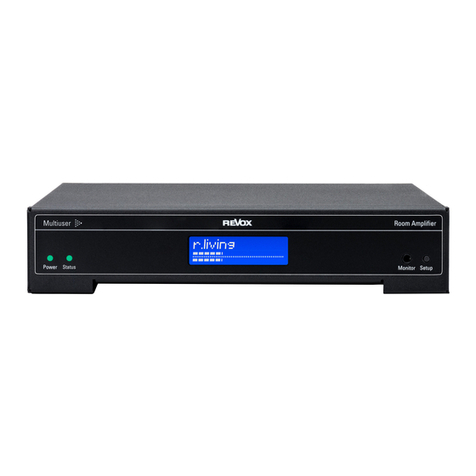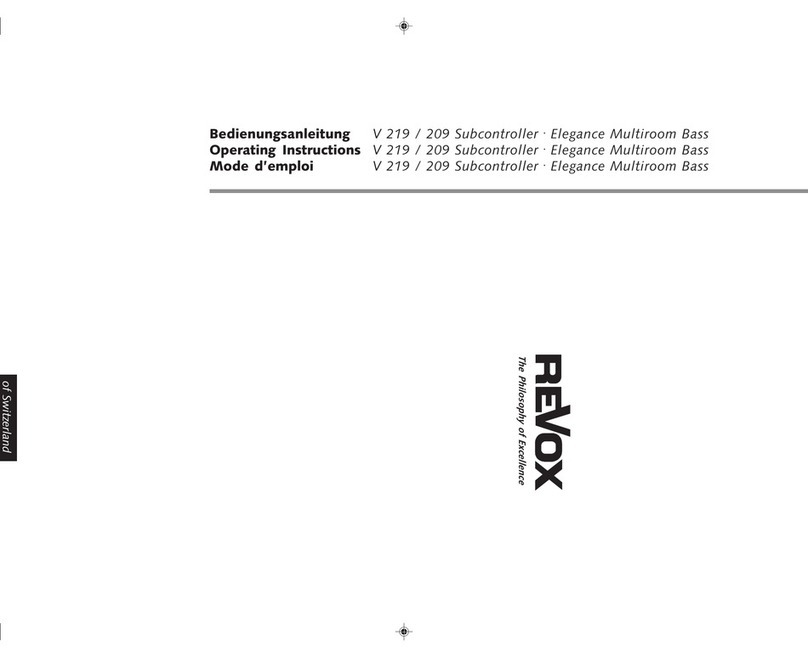13
Klangregelung BASS
(
Tiefen)
Stufenregler zur Beeinflussung der tiefen Fre-
quenzen für beide Kanäle (max. ±8dB bei
1
20 Hz).
14
Klangregelung PRESENCE
(
Präsenz)
Stufenregler zur Beeinflussung der mittleren
Frequenzen für beide Kanäle (max. ±8 dB bei
3 kHz).
15
Klangregelung TREBLE
(
Höhen)
Stufenklangregler zur Beeinflussung der hohen
Frequenzen für beide Kanäle (max. ±8 dB bei
8 kHz).
13
Tone control BASS
Step type control to alter the low frequency
response in both channels simultaneously (max.
± 8 dB at 120 Hz).
14
Tone control PRESENCE
Step type control to alter the mid-high fre-
quency response in both channels simulta-
neously (max. ± 8 dB at 3 kHz).
15
Tone control TREBLE
Step type control to alter the high frequency
response in both channels simultaneously (max.
±8 dB at 8 kHz).
13
Reglage de tonalite BASS
(grave)
Commutateur ä plots, qui agit Sur les fräquences
basses pour [es deux canaux (max. ± 8dB ä
1
20 Hz).
14
Räglage de tonalite PRESENCE
(
prä-
sence)
Commutateur ä plots, qui agit sur les fräquences
moyennes pour les deux canaux. (max. ± 8 dB ä
3 kHz).
15
Reglage de tonalitä TREBLE
(aigu)
Commutateur ä plots, qui agit sur les fräquences
äleväes pour les deux canaux (max. ± 8 dB ä
8 kHz).
16
Buchsen PHONES(Kopfhörer)
Für
den Anschluss von 2 Stereo-Kopfhörern mit
I
mpedanzwerten von 8 Ohm und höher (opti-
male Anpassung bei 100 Ohm). Die Kopfhörer-
ausgänge sind an den Endstufen angekoppelt,
sind aber bei abgeschalteten Lautsprechern in
Betrieb.
17
Ausgang TAPE 2 OUTPUT
(
Tonband 2)
Für den frontseitigen Anschluss eines Tonband-
gerätes (parallel zu Ausgang TAPE 2 38 ).
18
Taste TAPE 1
(
Monitor Tonband 1)
Schaltet unabhängig von der Stellung des Ein-
gangswahlschalters INPUT SELECTOR
(7)
das
an Buchse TAPE 1
35
angeschlossene Ton-
bandgerät auf den Verstärker (Tonbandwieder-
gabe, Hinterbandkontrolle).
19
Taste TAPE 2
(
Monitor Tonband 2)
Wie TAPE 1, jedoch das an Buchse TAPE 2
37
angeschlossene Tonbandgerät.
20
Taste TAPE COPY
(
Tonbandkopie)
Durch Drücken der Taste werden die beiden an-
geschlossenen
Tonbandgeräte miteinander ver-
bunden. Damit sind direkte Tonbandkopien in
beiden Richtungen möglich.
Mit den Tasten TAPE 1 und 2 kann die
Wiedergabe beider Tonbandgeräte über den Ver-
stärker kontrolliert werden.
Hinweis:
Während des Kopiervorganges kann am
Verstärker eine beliebige Tonquelle (INPUT
SELECTOR (7)
gewählt werden. Die Funk-
tionen des Verstärkers bleiben vollständig er-
halten.
21
Schiebeschalter PHONO 1 IMPEDANCE
25 kOhm, 50 kOhm, 100 kOhm
Zur optimalen Anpassung von Tonabnehmern,
die an Buchse PHONO1 33 angeschlossen
sind. (Normalstellung: 50 kOhm; Impedanz an
PHONO 2 beträgt 50 kOhm, festeingestellt).
22
Regler PHONO SENSITIVITY
Zur Anpassung der Empfindlichkeit der Ton-
abnehmer, angeschlossen an PHONO 1 und 2.
(
Nominalwert: 3 mV, regelbar ±7 dB).
16 Phones jacks
Permits the connecting of 2 stereophonic head-
phones with a nominal impedance of 8 ohms or
higher (optimum matching at 100 ohms). The
headphone jacks are wired to the outputs of the
power stages, however, they do remain active
even with the loudspeakers switched off.
17
Output TAPE 2 OUTPUT
Permits the connecting of a tape recorder (paral-
l
el to output TAPE 2 38 ).
18
Push button TAPE 1
This switch bypasses the INPUT SELECTOR
( (7)
and connects the socket TAPE 1
35 to
the amplifier's input (for after tape monitoring
or for the reproduction of a tape).
19
Push button TAPE 2
21
Same as TAPE 1, however, effective an socket
TAPE 2 37 .
20
Push button TAPE COPY
By pressing this button, two tape recorders (if
hooked up to the amplifier) will become con-
nected together in a manner which permits
transfer operations (copying) in either direction.
The buttons TAPE 1 and TAPE 2 will permit
after tape monitoring an both tape recorders.
Note:
During the transfer process any other
signal source may be selected at will by means
of the I NPUT SELECTOR (7)
All functions of
the amplifier remain fully in effect.
21
Sliding switch PHONO 1 IMPEDANCE
25 kohms, 50 kohms, 100 kohms
For optimum matching of phono cartridges con-
nected to the socket PHONO 1 33 . (Normal
position: 50 kohms; input PHONO 2 has a fixed
i
mpedance of 50 kohms.)
22
Control PHONO SENSITIVITY
Adjusts preamplifier gain to match the levels of
phono cartridges connected to inputs PHONO 1
and
PHONO 2. Nominal input sensitivity:
3 mV, control range ± 7 dB.
16
Prises PHONES
(
casque)
Pour le raccordement de casques stäräopho-
niques d'une impedance minimum de 8 ohms
(I'adaptation ideale est ä 100 ohms). Les sorties
casque sont couplöes aux etages finals et sont
toujours en Service meme lorsque les haut-
parleurs sont declenches.
(17)
Sortie
TAPE 2 OUTPUT
(
magnöto-
phone 2)
Pour le raccordement ä la prise frontale d'un
magnetophone (parallele ä la sortie TAPE 2
38
) .
18
Bouton poussoir TAPE
1
(
moniteur
pour magnetophone 1)
Commute directement ä I'amplificateur, le ma-
gnetophone raccorde ä la prise TAPE 1 35 et
ceci independamment de la position du sä-
l
ecteur d'entree (7)
(
Pour la lecture d'un ma-
gnetophone, le contröle apres bande.)
19
Bouton poussoir TAPE 2
(
moniteur
pour magnetophone 2)
Comme pour TAPE 1, avec le magnetophone
raccorde ä la prise TAPE 2
37 .
20
Bouton poussoir TAPE COPY
(
copie de
bande)
En enfonGant ce bouton, les deux magnäto-
phones raccordäs ä I'amplificateur sont reliäs
ensemble. Ainsi la copie d'une bande ä I'autre
peut s'effectuer dans les deux directions. Les
boutons poussoir TAPE 1 et TAPE 2 per-
mettent un contröle par I'amplificateur, de la
l
ecture des deux magnätophones.
Remarque:
Pendant la copie de bandes, I'ampli-
ficateur garde ses fonctions et n'importe quelle
source sonore peut etre äcoutee (INPUT SE-
LECTOR (7)
21
Commutateur ä glissiäre PHONO 1 IM-
PEDANCE
25 kohms, 50 kohms, 100 kohms
Pour I'adaptation d'impedance du phonocapteur
d'une table de lecture, raccodee ä la prise
PHONO 1 33 . (Position normale: 50 kohms;
(
'i
mpädance de I'enträe PHONO
2 est fixee ä
50 kohms.)
7

